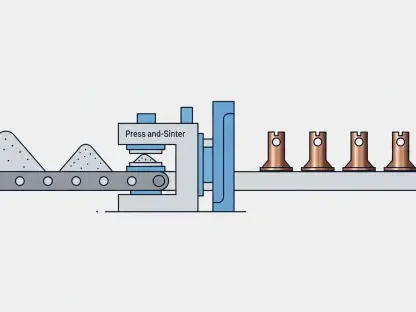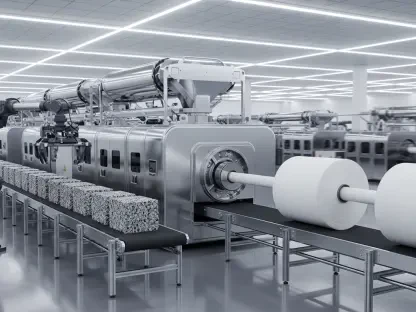Supply chain management (SCM) has become a critical focus for businesses worldwide, given the increasing disruptions caused by geopolitical tensions, natural disasters, and shifting consumer demands. Companies are now forced to reimagine their supply chains to remain competitive, responding to an environment where agility, technology, and sustainability are not just buzzwords but essential components of survival and success.
The Importance of a Robust Supply Chain
Navigating Post-COVID Challenges
In the aftermath of the COVID-19 pandemic, businesses encountered unprecedented disruptions revealing numerous vulnerabilities within their supply chains. Companies were compelled to rethink and often overhaul their operational strategies to cope with these strains. Dan Myers from XPO Logistics emphasizes that while achieving a perfect supply chain remains an idealistic goal, striving for near-perfection is imperative in today’s volatile conditions. XPO assists clients in managing these fluctuations through solid inventory and capacity buffers, which have proven crucial in mitigating the unpredictability of post-pandemic markets.
The pandemic exposed weaknesses that many companies were either unaware of or had underestimated. A robust supply chain today not only has to account for conventional risks but also adapt to unexpected shifts in consumer demand, abrupt shutdowns of manufacturing hubs, and bottlenecks in logistics networks. Flexible supply chains with robust buffers ensure businesses can recover swiftly from such disruptions. For example, by implementing advanced forecasting techniques and diversified sourcing strategies, firms can better anticipate and cushion against market shocks, thereby maintaining continuity and customer trust.
The Fragility of Supply Chains
Over the last decade, the fragility of global supply chains has been seriously tested by a series of geopolitical events, climate-induced disruptions, and evolving market dynamics. Brian Gerritsen notes that controlling the controllable aspects of the supply chain has become a survival strategy for many businesses. This means having a clear understanding and command over factors within their control, like inventory levels, supplier relationships, and logistical arrangements. SCM’s goal is no longer just to respond to challenges as they arise but to foresee and mitigate them as much as possible.
Building a resilient supply chain requires a proactive stance where predictive analytics and risk management play central roles. For instance, real-time data analytics can provide actionable insights into potential disruptions, prompting preemptive measures. Companies are also investing in multi-tier supplier networks to avoid dependence on single points of failure. By maintaining a diverse supplier base and establishing strong communication lines with all stakeholders, businesses can create more stable and robust supply chains capable of withstanding and quickly recovering from external shocks.
Agility Versus Resilience in SCM
Embracing Agility
Dr. Tom Goldsby advocates for agility over traditional resilience in the realm of supply chain management. Agility is about the ability to swiftly adapt and respond to disruptions with a flexible approach that turns challenges into opportunities. During the pandemic, businesses that managed to excel were those that rapidly leveraged new capabilities to enhance their market positions. Agility in SCM means being able to reroute logistics, switch suppliers, or alter production plans on short notice, minimizing downtime and maintaining service levels.
Adopting an agile SCM strategy involves operating with a mindset centered on continuous improvement and rapid response. It requires businesses to stay vigilant and prepared for a wide array of potential disruptions. Agile supply chains characterized by adaptability can switch gears quickly, such as moving production to alternate locations or tweaking product lines to meet new market demands. This dynamic approach ensures that businesses are not just surviving but thriving by capitalizing on unforeseen opportunities that emerge from disruptions.
Operational Benefits of Enhanced SCM
The operational benefits of enhanced SCM are manifold, encompassing lower costs, increased efficiencies, and improved financial visibility. Dan Myers points out that effective SCM practices provide businesses with the tools needed to make smarter purchasing decisions, enhance customer satisfaction, and achieve more sustainable operations. With better data and systems in place, companies can streamline processes, reduce waste, and forecast demand with higher accuracy, all of which contribute to a more profitable and resilient business model.
Enhanced SCM also allows businesses to strengthen their competitive edge by optimizing their supply chain activities. This involves leveraging advanced technologies like predictive analytics to gain insights into market trends and consumer behaviors, enabling more informed decision-making. By improving coordination across different functional areas—such as procurement, production, and distribution—companies can enhance operational synergy, reduce lead times, and improve service delivery. These efficiencies translate into tangible financial savings and increased agility, positioning businesses to better navigate future disruptions.
The Role of Technology in SCM
The Impact of Emerging Technologies
Emerging technologies such as artificial intelligence (AI), machine learning (ML), and automation are reshaping the landscape of supply chain management. Brian Gerritsen highlights that these technologies enable businesses to manage operational efficiencies while providing deeper insights into global supply chains. AI and ML algorithms can process vast amounts of data to predict disruptions and recommend optimal responses, while automation helps streamline repetitive tasks, freeing human resources for more strategic decision-making.
Technology plays a transformational role in enhancing supply chain visibility and responsiveness. For example, AI-driven predictive analytics can identify potential risks in supply chains by analyzing patterns in data, allowing businesses to take preemptive actions to mitigate these risks. Blockchain technology is another significant innovation, providing a tamper-proof record of transactions, which increases transparency and trust among supply chain partners. By integrating these technologies, companies can create smarter, more responsive supply chains that are better equipped to handle the complexities of modern business environments.
Digitalization and Supply Chain Efficiency
Digitalization has emerged as a game-changer for supply chain efficiency. Dr. Tom Goldsby describes digital tools as offering improved vision, better decision-making, and timely action. The pandemic accelerated digital adoption, compelling businesses to leverage digital technologies to meet rapidly changing demands while ensuring employee safety. This shift is not merely a response to temporary challenges but represents a long-term strategic upgrade in SCM practices.
Digitalization enables end-to-end visibility across the supply chain, from sourcing raw materials to delivering finished products to consumers. This transparency facilitates better coordination and more informed decision-making. For instance, digital twin technology allows companies to create virtual replicas of their supply chains, enabling them to run simulations and identify potential bottlenecks before they occur. Additionally, Internet of Things (IoT) devices provide real-time monitoring of assets and inventory, ensuring timely interventions when needed. These advancements collectively enhance supply chain resilience, agility, and efficiency, making digitalization a cornerstone of modern SCM strategy.
Sustainability as a Core Component
Consumer Demand for Sustainable Practices
Modern consumers increasingly demand transparency and sustainability in the products they purchase. Brian Gerritsen emphasizes that businesses must transition to sustainable suppliers and optimize transportation networks to reduce their environmental impacts. Companies that fail to meet these expectations risk losing market share and damaging their brand reputations. Sustainable SCM practices involve scrutinizing every link in the supply chain to ensure compliance with environmental standards and identifying opportunities for reducing carbon footprints.
Sustainability is now a critical element of competitive strategy. Consumers are more informed and selective, often prioritizing brands that demonstrate a commitment to environmental stewardship. To meet these expectations, businesses are adopting green logistics solutions, such as using electric vehicles for last-mile delivery and optimizing delivery routes to minimize fuel consumption. Companies are also focusing on sustainable sourcing by partnering with suppliers that adhere to stringent environmental and ethical standards. These sustainable practices not only satisfy consumer demand but also contribute to the broader goal of corporate social responsibility.
Sustainable Development and SCM
Sustainability is becoming deeply intertwined with core business strategies, aligning with global initiatives such as the United Nations Sustainable Development Goals (SDGs). Dr. Tom Goldsby asserts that SCM must integrate environmental stewardship and societal needs to achieve true sustainability. This holistic approach involves not just environmental considerations but also addressing social and economic impacts, making sustainability an integral part of business operations rather than a standalone initiative.
Sustainable development in SCM requires a comprehensive strategy that encompasses the entire supply chain lifecycle. This includes designing products with minimal environmental impact, optimizing manufacturing processes to reduce waste, and ensuring ethical labor practices throughout the supply chain. Moreover, companies are investing in renewable energy sources and innovative technologies to lower their carbon footprints. By embedding sustainability into their core SCM strategies, businesses can achieve long-term viability, enhance their corporate reputation, and contribute positively to global sustainability efforts.
Implementing Sustainable Supply Chain Practices
Green Logistics Solutions
Dan Myers discusses the transformative steps businesses are taking to reduce their carbon intensity and environmental impact. Companies are deploying carbon-neutral fleets and investing in renewable energy sources to power their operations. Initiatives such as converting diesel-powered vehicles to run on sustainable fuels like hydrotreated vegetable oil (HVO) and shifting freight transportation to rail are just a few examples of the efforts being made to achieve greener logistics.
Implementing green logistics solutions requires a significant commitment from businesses to rethink and reengineer their supply chain practices. For instance, using electric vehicles for delivery not only reduces emissions but also enhances operational efficiencies by lowering fuel and maintenance costs. Similarly, investing in renewable energy sources, such as solar panels for warehouses, reduces reliance on fossil fuels and cuts operational costs over time. These initiatives are crucial in moving towards a more sustainable future, reflecting a balance between economic benefits and environmental responsibility.
Benefits Beyond Compliance
Embracing sustainable practices offers numerous benefits beyond mere regulatory compliance. Companies that take proactive steps toward sustainability can achieve significant financial savings, reduce waste, and lower energy consumption. Furthermore, these practices often lead to innovations that can open new market opportunities. Companies that prioritize sustainability can enhance their brand image, attracting environmentally conscious consumers and investors, and ultimately achieving a competitive edge.
Sustainable supply chain practices also foster a culture of innovation within organizations. As businesses strive to meet sustainability goals, they are often driven to explore new technologies and methods, leading to process improvements and product innovations. For example, developing biodegradable packaging materials not only reduces environmental impact but also appeals to eco-conscious consumers. By viewing sustainability as an opportunity rather than a constraint, companies can unlock new revenue streams, improve efficiencies, and build stronger relationships with stakeholders who value environmental stewardship.
Conclusion
Supply chain management (SCM) has become a pivotal concern for businesses around the globe. The rise in geopolitical tensions, natural disasters, and changing consumer preferences have heightened the sense of urgency to develop resilient and flexible supply chains. As a result, companies are compelled to rethink their strategies, focusing on adaptability, innovative technology, and sustainability not just as trendy buzzwords, but as crucial elements for their survival and prosperity.
Today’s business environment demands that companies implement SCM practices that are agile and robust enough to navigate unpredictable crises and disruptions. Technological advancement plays a significant role in this transformation, offering tools like artificial intelligence, blockchain, and IoT (Internet of Things) to streamline operations and improve transparency throughout the supply chain. Moreover, sustainability has emerged as a key priority. Companies are increasingly aware that sustainable practices are not only good for the planet but are also beneficial for their long-term profitability and brand reputation. Therefore, businesses must integrate eco-friendly practices to meet consumer expectations and regulatory demands.
In essence, effective supply chain management today is about being prepared for the unexpected, leveraging technology for efficiency, and committing to sustainability. These aspects are no longer optional but are necessary for companies aiming to stay competitive in an ever-changing global market.









